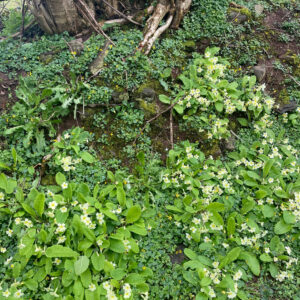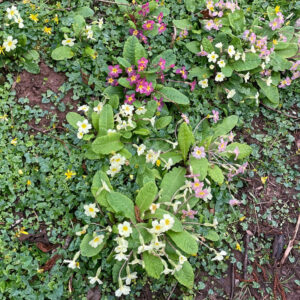The Primrose
Primroses and Old Tracks
One of my favourite things to do is to find ‘old tracks’. These can be in form of a single track read or a muddy path, but both are characterised by deep sided banks, which hold a rich biodiversity of plants, undisturbed for hundreds of years. I often feel a certain presence walking these tracks, a calling, a feeling of age, of people in the past, horses, carts and wagons travelling these ways over millennia. They hold a timeless peace and energy
It was up one of these paths that I walked on Easter Monday to the remarkable old Church at Pencelli, near Brecon. The Church is set in a remote place, surrounded by ancient heritage Yew trees. It felt like a pilgrimage. The track was deep and had the remains of a coppiced Hazel. A dappled shade filled the track and, on the bank, spread like butter, was a beautiful clump of our native wild primroses. This little, soft yellow flower, sometimes pink or caramel, flowers from February all the way through to May, thereby offering essential sustenance to emerging Queen Bumblebees as they come out of hibernation. You can often hear the deep humming of a Queen as she forages on these banks, looking for food and a hole in which to start a nest. These undisturbed banks offer her a myriad of flowers on which to feed, such as Celandine, Wood Anemone, white and purple Violets, Vetches, Spurges, Wild Strawberry and Eyebright to name but a few
I was surprised to learn that the leaves of the wild Primrose are edible, but foraging for these is not to be encouraged when our wild flowers are declining in numbers and are so under pressure from habitat loss. There are good organic salad bags available in our booming farm shops, many offering a collection or delivery service, such as my local Penpont Farm Shop
I am lucky enough to occasionally walk the tracks that I had walked as a child with my mother, and she had done the same with her mother. I notice that plants that I saw growing as a child are no longer there and it is this ‘baseline memory’ that I am most concerned about. What if my child in turn does not know or see that there was once a bank of primroses growing in a place where I saw them in my youth. Will they care that they are not there any longer? And that piece of knowledge is lost forever. And if by chance the habitat was restored, would anyone know that there were once primroses growing there
Athene English

